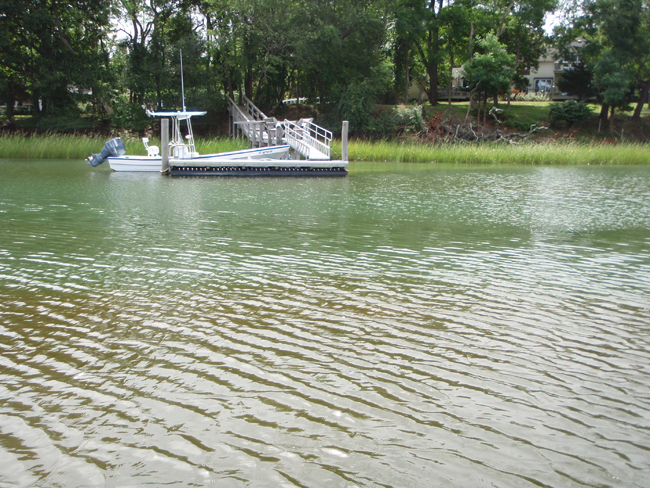
A brown tide bloom in West Neck Bay, Shelter Island Heights. Credit: Peconic Estuary Partnership
Contact:
Antoinette Clemetson, NYSG Marine Fisheries Specialist, P: 631-632-8730, E: aoc5@cornell.edu
Public input can help waterfront managers to improve their marine harmful algal blooms response and better leverage resources
Stony Brook, NY, March 8, 2021 - Harmful algal blooms (HAB) have increased in their occurrence and severity in Suffolk County over the past two decades, resulting in economic loss when shellfish harvesting and/or bathing beach closures are imposed.
In 2017, Suffolk County engaged New York Sea Grant (NYSG) for assistance in the creation of the Suffolk County Harmful Algal Bloom Action Plan, www.nyseagrant.org/habsactionplan (pdf).
NYSG used funding from the National Centers for Coastal Ocean Science (NCCOS) Ecology and Oceanography of Harmful Algal Blooms to hold a public symposium in 2018 to share how the plan would support HAB management in Suffolk County, and to organize a technical working group meeting to coordinate data collection and monitoring. Workgroup participants identified the need for the agencies involved with seasonal HAB monitoring to have access to a central data repository. NYSG led an effort in 2019 and 2020 to build this capacity and to move closer to the County goal to convey real-time public alerts on HABs. NYSG co-funded this project to develop an online tool for the public to report marine algal blooms and as an archive of seasonal HAB monitoring results. NYSG hired a student with ArcGIS skills to modify a survey instrument, used for capturing similar information for freshwater HAB outbreaks, to use in the marine district.
The Suspicious Marine HAB Reporting Tool was presented at the 2020 Harmful Algal Bloom Virtual Symposium and piloted in summer 2020. This web-based tool enables users to report marine HAB outbreaks in real time by pinpointing locations on a map; this capability ultimately helps to improve administrative decisions that Suffolk County makes for monitoring team deployment. Suffolk County used this tool to migrate five-year, Excel-based historical datasets for four HAB species into a centralized database.
Project Partners:
• Funding: NCCOS Ecology and Oceanography of Harmful Algal Blooms (ECOHAB)
• Suffolk County Department of Ecology
• New York State Department of Environmental Conservation Fresh Water Unit
• Stony Brook University School of Marine and Oceanographic Science (SoMAS)
More Info: New York Sea Grant
New York Sea Grant (NYSG), a cooperative program of Cornell University
and the State University of New York (SUNY), is one of 34 university-based
programs under the National Oceanic and Atmospheric Administration’s
National Sea Grant College Program.
Since 1971, NYSG has represented a statewide network of integrated
research, education and extension services promoting coastal community
economic vitality, environmental sustainability and citizen awareness
and understanding about the State’s marine and Great Lakes resources.
Through NYSG’s efforts, the combined talents of university scientists
and extension specialists help develop and transfer science-based
information to many coastal user groups—businesses and industries,
federal, state and local government decision-makers and agency managers,
educators, the media and the interested public.
The program maintains Great Lakes offices at Cornell University, SUNY
Buffalo, SUNY Oswego and the Wayne County Cooperative Extension office
in Newark. In the State's marine waters, NYSG has offices at Stony Brook
University in Long Island, Brooklyn College and Cornell Cooperative
Extension in NYC and Elmsford and Kingston in the Hudson Valley.
For updates on Sea Grant activities: www.nyseagrant.org has RSS, Facebook, Twitter, Instagram, and YouTube links. NYSG offers a free e-list sign up via www.nyseagrant.org/nycoastlines for its flagship publication, NY Coastlines/Currents, which is published quarterly.